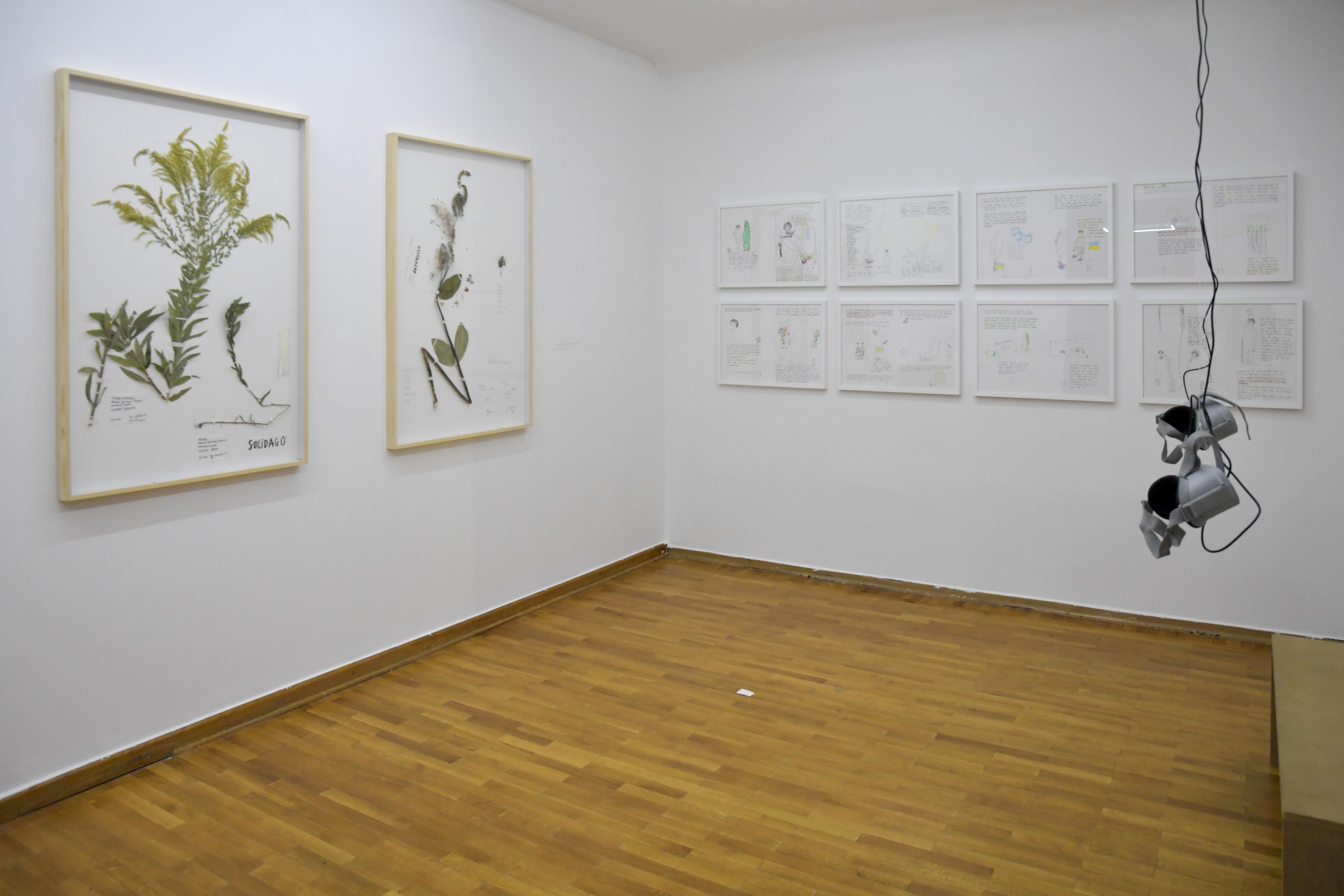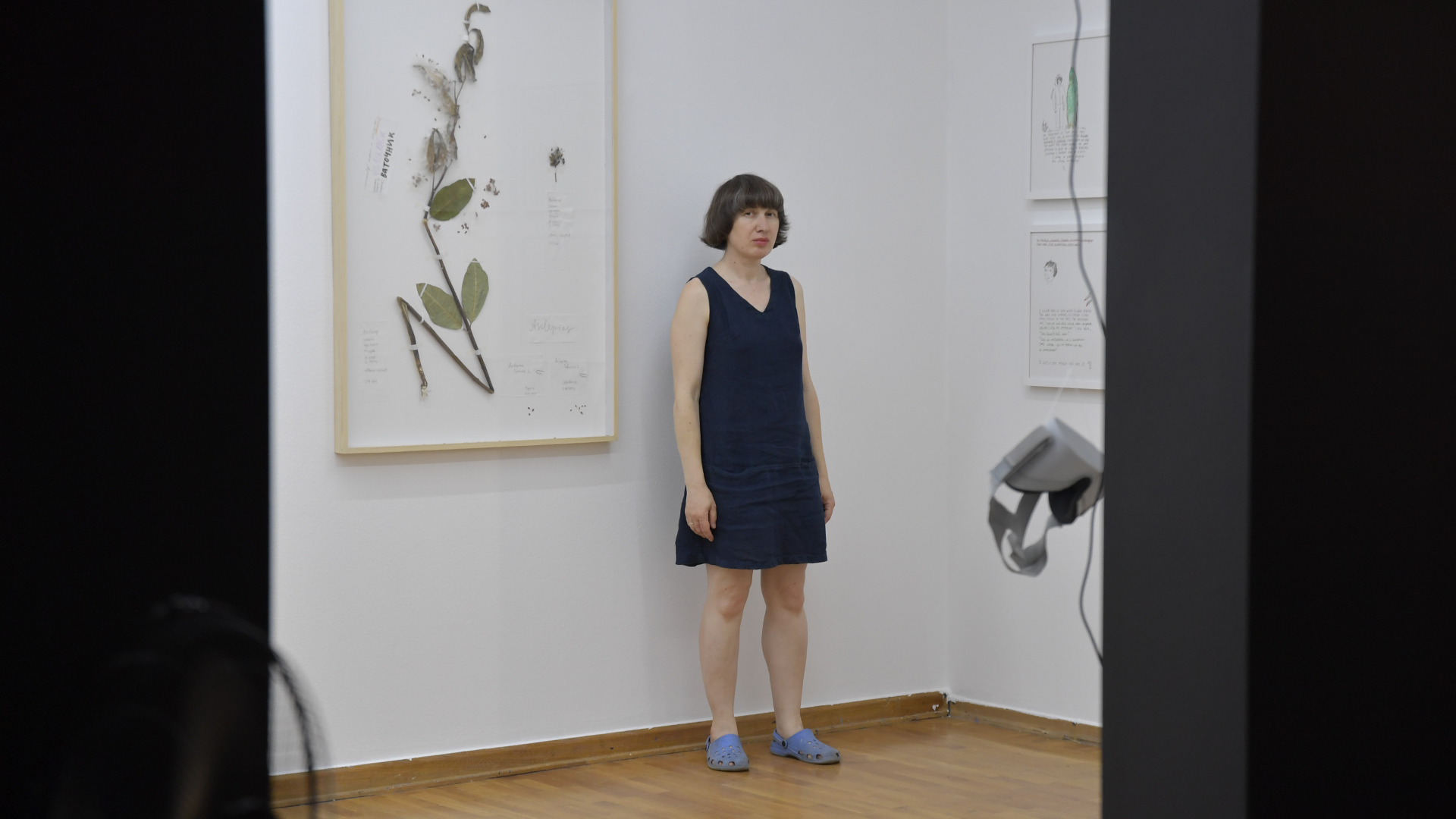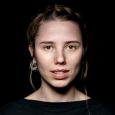For 100 days Kosovo’s National Gallery will be the home of “Invasions,” the work of Ukrainian visual artist Alevtina Kakhizde, one of the artists participating in the 14th edition of Manifesta, the European Nomadic Biennial which is taking place in Prishtina this year.
Kakhizde comes back to Manifesta after eight years, when she presented her work “Where the Wild Things Are” in the 2014 edition in Russia. In both editions of the biennial she has participated in, Kakhizde’s artistic contributions have focused on war, production of weapons and peace.
Coming from Muzychi, only 26 kilometers from Kiev, Ukraine, it is inevitable that Kakhizde would talk about war. Like her late mother, who is a key figure in Kakhizde’s work and who had been living in Russian-occupied eastern Ukraine for years, Kakhizde chose to stay in Ukraine after the Russian invasion in February 2022. When she was presented with multiple offers to be sheltered elsewhere, she thought, “What happens to my neighbors who don’t get this opportunity?”
Kakhizde’s most recent work focuses on plants, which are for her examples to follow, examples of pacifism on earth. Currently on view at Kosovo’s National Gallery are herbariums featuring plants Kakhizde collected from Lawrence, Kansas, and Ukraine alongside a 360° movie that includes conversations with her friends about plants, the war, home and loss. The work draws a parallel between the invasion of a country, as is happening in Ukraine, and the threats invasive plant species create for native plants.
In her conversation with K2.0, she explained how eight years ago she started talking about the war through publishing a graphic novel based on her conversations with her mother, Strawberry (as she named her in her work), who at the time was living in her house in Russian-occupied eastern Ukraine. Eight years later, Kakhizde is experiencing first-hand some of the same things her mother had been telling her about: the shellings, the fear and bravery, the dark anticipation of what might happen next.
K2.0: In 2014, you participated in Manifesta 10 in St. Petersburg, Russia with your work Where the Wild Things Are. A lot has changed in the world since. What has changed in you as an artist?
Alevtina Kakhizde: In 2014, I started to talk about war, and I am still stuck there. I didn’t decide to talk about this war, but it is impossible to avoid it. It’s like avoiding reality. In St. Petersburg was the beginning of everything. It’s amazing that they invited me. I met with Kasper König [the curator of Manifesta 10], and he said, ‘What do you think, when will the war be over?’ I said, ‘I will send you a postcard when it’s over.’
No one knows. Who can say? What will happen? And in Manifesta 10, it was the time when everything started for Ukraine. We had a hybrid war, at the time Ukraine was struggling, saying to the world that we have a Russian invasion. No one believed us at the time. I was talking about this because look, my mom was living over there, in occupied territory and I phoned her every day and she told me whatever she could see, and I created a graphic novel. And then she died at a checkpoint, in 2019. The beginning of the 360° film [featured at Manifesta] is near the grave of my mom. I didn’t go to the place where she died. The body was brought to me and I buried her in the village where I live now. And you saw the grave, and the grave is actually the house she did not want to leave because it was her life.
When someone asked you why you didn’t get your mom out, you said, “what is she, furniture?”
It was the question for many Ukrainians. Because people decided to stay under occupation and it was such a hard issue for Ukrainians for eight years. Some really did not understand how they could survive but some had close relatives there. I had my mom, we talked a lot about this and she made her decision to stay over there.
This is why when my friends ask me why I didn’t take her… It was obvious, how can I go and take her, because she is not a piece of furniture, she is a person, she has her own right to decide where to live. Of course, it was clear that all her life was there. The house kept her, the garden and the land and everything was so important for her. And then, since I could not actually bury her over there, near her house, I decided to bring the house to the cemetery, where I decided to bury her, and I symbolically shift the house to the place where she actually is now.
In the movie, as you are sitting near your mother’s grave, you say ‘this is my room, this is my bedroom.’ What does that mean?
I created this grave, this memorial, and people really liked it, because so many Ukrainians they knew, their parents couldn’t really live in the area under occupation and they died under occupation, lonely, without help, like it happened with my mom… the ambulance could not go… everything because of the war. So this is the story that I started in Manifesta 10, the war just started, and now I am eight years older. I’ve experienced everything that my mom told me about.
What was it like to translate into art everything your mom was experiencing?
In the beginning, it was easy, it helped because when you share things it gives you energy. But then it becomes like a duty and sometimes it’s so hard being in this process when you call mom and she doesn’t answer. I still did this, and to a certain point of course I showed the work to my mom.
Many people asked whether I was instrumentalizing my own mom in order to tell my story in art. I asked her, look, whatever I did, here is the book, here are the animations, the drawing, the text, so please look and I am going to walk my dog and I will be back in three hours. And then she said, I’d like to take it with me, to show it to my friends in the occupied territory. She was very brave.
I was just listening to her, she needed to tell me these things. And I had to know what was happening to her. I was reporting for five years. It was very important to be honest. I was putting it all on Facebook. Then I took everything off Facebook because I had these files for five years, and I was afraid that Facebook would not work or somebody would ban my account. The files are a document that tells me what happened day by day. Even now, when I am reading this I am amazed how things were in parallel between what my mom was hearing in the market and the kind of propaganda that existed there.
I was documenting how people were talking, and of course, they could be wrong, they could say stupid things but it was how things were talked about from the perspective of an old lady.
One thing is, I was writing about how they were hiding in the cellar when the shelling would begin, and then I had the same experience, and it was such a deja vu, because you know she just told me I don’t want to go to the cellar, because it’s wet and dark, because I was asking why aren’t you in the cellar, it’s dangerous to sleep on your bed.
And then I understand later when it’s so unpleasant to be in the cellar, at one point you say, okay just kill me, whatever, but I like to be in my bed, I like to have a bath because I remember that I didn’t take my clothes off for two weeks, and I noticed that my skin started itching and then I remember when I was having a bath, and there was shelling, and I just said, fuck you I just will be in the bath. And I have a drawing where I’m in the bath and the shelling is happening.
I remember there was this thunderstorm. I remember that my mom said that there was a thunderstorm, and they immediately went to the cellar, they mistook it for shelling, and then it was just rain. And exactly the same happened to me, I also thought, oh my God, such a scary shelling, and it was rain. Then I posted this drawing, and all my friends reposted it but when I did this drawing in 2014, no one even understood it. People were like, maybe Alevtina just invented something.
Your narrative with Strawberry, or, your mother, is very detailed and intimate.
It’s not something that a journalist could do. Journalists could never get this intimacy. They never could really receive these very true answers. They couldn’t have so much time also. And my mom never talked to them. This is just the power of the heart.
When the invasion started, I didn’t run away. I basically did what my mom did. I would say it’s scary. I remember when it was such heavy shelling and I remember that my hands were really shaking. Of course, I was scared. I have a drawing. What am I scared of? To be occupied? At that time I didn’t know that Russians could be so cruel. I said no. Then secondly, to be killed? Anyway, we will die. And the thought that was still kind of tricky was the idea of being injured, heavily injured.
We wanted to be in Ukraine. Our men can’t leave the country. Many institutions would like to host me, just because they say I am a well-known artist, but what to do with my neighbors in the village? They can’t get this opportunity, they don’t speak English. When so many people tell me, ‘Alevtina, run away, we’d like to offer our homes in peaceful countries,’ I say ‘What about the others?’ This is one issue, how westerners always think that hosting refugees is a strategy. That’s not a strategy. To stop the war, this is the strategy. Then there will be no refugees. No one in Ukraine wants to be a refugee.
You’ve said that we cannot speak about pacifism, but your art is constantly calling for it. You have chosen to work with plants because you call them pacifists.
Plants can also dominate. They can be faster than other plants. Some plants can kill insects. But they don’t kill each other in a moment. So they are absolutely different. And since they have totally different built bodies, they don’t have organs, they don’t have a heart, a brain and when you take a part of the plant, they don’t run, they can’t become refugees. Because they can sacrifice a part of their body, and somehow rebuild it. They build themselves in a way that some part of them could be taken by somebody, this is why they can’t fight against humans who, let’s say, come with scissors to cut them.
They are not angels. They can take more and more areas and have bigger leaves, and longer roots.
As an artist, you are very engaged politically. Is this intentional or a byproduct of your process and interests?
I don’t remember the last time I asked myself this question. I never divided politics and life. For me, it’s so obvious. Even if I try, I can’t. I would love to do something that is not political, but it is impossible. Everything is political.
You mix writing and drawing. Do you consider yourself a writer?
I’m not a real writer. I don’t have so many readers, sometimes people come to a show, they don’t spend time reading. I really want people to read what I write. Sometimes they don’t have time for it. For writers it’s obvious, they produce writing. But when I produce a text, I think sometimes people don’t look at it so much.
What does it mean to be a Ukrainian artist now?
In Ukraine, artists are mainly political. But sometimes, you have to be brave enough to talk about politics, sometimes, it’s hard, you know, because it’s a responsibility. To write that pacifism doesn’t exist anymore… you can lose your friends.
Sometimes, you think that your voice is small. You feel ashamed that you are producing art. Can it help? No, I’m not so… even producing art, I have some shame, because some of the artists in Ukraine, they went to the frontline.
This article has been edited for length and clarity. The conversation was conducted in English.
Feature image: Atdhe Mulla / K2.0.



